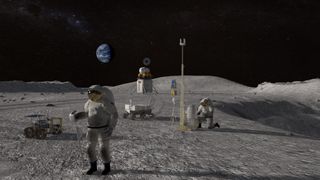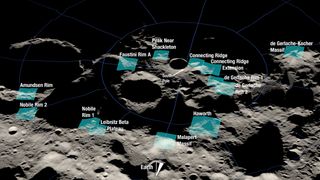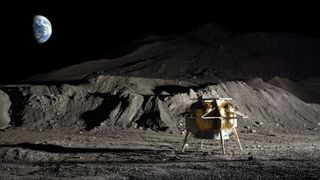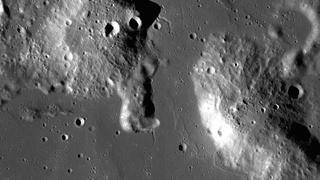As NASA nears return to the moon with Artemis program, lunar scientists' excitement reaches fever pitch
Plans to return astronauts to the surface of the moon and dozens of supporting robotic science missions promise to transform lunar science.

With NASA's Artemis 1 mission launching to the moon this month, Space.com is taking a look at what we know about the moon and why we care. Join us for our Moon Week special report in the countdown to Artemis 1.
Lunar science is set to be transformed by NASA's Artemis moon program, which will send astronauts to the moon's surface after an absence of over 50 years and launch nearly five dozen robotic missions over the next three years.
The Artemis 1 mission is currently scheduled to launch Aug. 29, with an uncrewed Orion capsule atop a mighty Space Launch System rocket — NASA's largest, most powerful rocket since the Saturn V that powered the Apollo missions. The capsule will travel around the moon before heading back for a splashdown on Earth, paving the way for a crewed mission to orbit the moon in 2024 and then for astronauts to land on the moon's south pole region as early as 2025 or 2026.
It will be the first time astronauts have walked on the moon since the Apollo 17 mission in December 1972, and it brings new opportunities for science.
Related: The ultimate guide to observing the moon
"Humans offer an incredible resource in going back to the surface of the moon," Debra Needham, a planetary scientist at NASA's Marshall Space Flight Center in Huntsville, Alabama, told Space.com.
Purely robotic missions are slow, feeding everything through their human controllers back on Earth.And although the introduction of artificial intelligence has automated this process somewhat, a robot does not have the quick thinking, curiosity or dexterity to make collecting rock samples an efficient process, for example.
Get the Space.com Newsletter
Breaking space news, the latest updates on rocket launches, skywatching events and more!
"It's easier for an astronaut to pick up a rock and then, out of the corner of their eye, see another rock and immediately note it as interesting," Ryan Watkins, a planetary scientist at NASA's Jet Propulsion Laboratory, told Space.com. "Real-time decision making is a lot quicker and more efficient."

The first landing site
To accomplish the best science possible, astronauts must go to the right locations on the moon. The six Apollo landing sites were clustered in a region on the nearside of the moon. Artemis 3, which is set to be the first Artemis mission to put boots in the lunar regolith, will instead venture to the lunar south polar region. Not only is this region attractive for its copious amounts of water ice hidden in permanently shadowed craters, but it is the first time astronauts will have gone there, far from the Apollo landing sites.
"While they were fairly distributed on the surface, the Apollo missions still basically went to one section of the moon that may have been influenced by the very large impact that created Mare Imbrium," Needham said. Mare Imbrium ("Sea of Rains") is a giant, 712-mile-wide (1,146 kilometers) impact basin that was formed 3.9 billion years ago and was then flooded with lava.
Scientists have speculated that the creation of this impact basin coincided with the Late Heavy Bombardment, which was proposed as a period between 4.2 billion and 3.9 billion years ago when the inner planets were being pelted by asteroids and comets. However, recent discoveries have cast doubt on this theory, and sampling other parts of the moon could help to settle the debate.
"One reason that we're going so far away from that impact basin is to be able to access different rock types that are potentially older and preserve a record of a more ancient moon," Needham said. "We'll be able to get a good sense of whether there was a period of really intense bombardment or not."

Lots of robotic science
Artemis isn't only about astronauts. Although humans will be able to do greater science in a shorter time, plans for just one crewed mission per year mean that astronauts won't be able to be everywhere on the moon. So, to assist lunar science during the Artemis program, dozens of robotic experiments will be delivered to locations all across the moon between 2022 and 2025. These experiments are being facilitated through the Commercial Lunar Payload Services (CLPS), in which commercial contractors are working with NASA on a $2.6 billion program to launch small science missions to the moon, with 46 payloads finalized so far.
Watkins said that her personal favorite payload is a probe called the Lunar Vulkan Imaging and Spectroscopy Explorer (Lunar-VISE), which will land on the Gruithuisen volcanic domes that lie between Mare Imbrium and Oceanus Procellarum ("Ocean of Storms"), and that Watkins studied as a student using orbital data.
These domes are believed to be silicic, meaning they were formed by silica-rich magma. But on Earth, silicic-based volcanic constructs require plate tectonics and form near plate boundaries in the oceans. How, then, could they have formed on the moon, which had neither oceans of water nor plate tectonics? There are some geological theories, and Lunar-VISE will be equipped with both a stationary lander and a rover that will make compositional measurements at various locations around the domes to test the various theories.

Water on the moon
Needham is also excited by many of the payloads in the CLPS program, including the Near Infrared Volatile Spectrometer System, the Neutron Spectrometer System on a small robotic rover called MoonRanger, and the Mass Spectrometer Observing Lunar Operations. Multiple copies of these three instruments will be delivered to the moon by Pittsburgh-based Astrobotic Technologies later this year and by California-based Masten Space Systems in 2023. They will operate in unison to detect and study the range of "volatiles" — compounds with low boiling points, like water and carbon dioxide — on the lunar surface, in the near-subsurface, and just above the surface, in the thin "exosphere."
"What's neat is that we're flying several copies of these payloads, with the first iteration going to a nonpolar region, and then we'll also send them to a polar region in a later delivery," Needham said. "So we're going to be able to compare these two very different parts of the moon using the same instruments."
At first glance, the moon doesn't look wet, and examinations of the rock samples brought back to Earth by the Apollo missions found them to be bone-dry. But aside from the ice hidden in the cold traps of permanently shadowed craters at the poles, water molecules (or at least hydroxyl molecules, which are a proxy for water formed from an oxygen atom joined to a single hydrogen atom, rather than two hydrogen atoms as in the case of water) have been observed migrating across the lunar surface near the day-night terminator. These observations were initially made by NASA's Moon Mineralogy Mapper instrument on board India's Chandrayaan-1 lunar orbiter in 2009, and in 2020, the soon-to-be-retired Stratospheric Observatory for Infrared Astronomy (SOFIA), which flies in the back of a modified Boeing 747, confirmed the presence of water molecules near the surface of the moon, albeit in a very thin veneer.
"We now know there's water pretty much everywhere on the moon," Needham said. "But it's from a different source and in a different form than the water in the south polar region. These payloads can give us some ground-truth to the remote measurements, and that's important for feeding into models describing water circulation on the moon."
It's not yet clear how sustainable the human spaceflight part of the Artemis lunar program is and whether more crewed missions will land on the moon's surface after Artemis 3, given that each launch will cost in excess of $4 billion. On the other hand, the relatively lower cost of the CLPS part of the Artemis program will guarantee the delivery of dozens of scientific experiments all across the moon, giving scientists an unprecedented volume of new data to decipher.
"We're greatly looking forward to the discoveries that we're going to make at new locations on the surface of the moon," Needham said.
NASA's Artemis 1 mission to the moon will launch on Monday (Aug. 29) during a two-hour window that opens at 8:33 a.m. EDT (1233 GMT). You can watch live launch coverage courtesy of NASA and follow Space.com's live updates on the mission.
Follow Keith Cooper on Twitter @21stCenturySETI. Follow us on Twitter @Spacedotcom and on Facebook.
Join our Space Forums to keep talking space on the latest missions, night sky and more! And if you have a news tip, correction or comment, let us know at: community@space.com.

Keith Cooper is a freelance science journalist and editor in the United Kingdom, and has a degree in physics and astrophysics from the University of Manchester. He's the author of "The Contact Paradox: Challenging Our Assumptions in the Search for Extraterrestrial Intelligence" (Bloomsbury Sigma, 2020) and has written articles on astronomy, space, physics and astrobiology for a multitude of magazines and websites.
